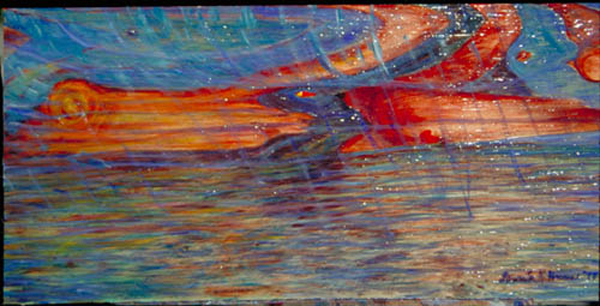Lacey DeCaire
"Native Art a Different Perspective"
By: Lacey DeCaire
NATI2506
Native People and the Arts
Professor Dumont at The Laurentian University, Sudbury
August 3, 2007
The following paper will attempt to identify the links to culture, tradition, origins and identity through the imagery, style, content and composition of LauraLee K. Harris's artwork to that of the earliest art of the aboriginal peoples; in taking a "Deeper Look Inside, Paintings Through the Grains."
Harris's artwork is that of a different realm. The paintings seem to have a life of their own. The use of colours are so moving, they seem to almost pop right of the wood into your being. Harris's style is exceptional and inimitable.
The following is a brief introduction of the artist. LauraLee K. Harris was born in Toronto in 1956, it is said that she drew and painted from the time she was able to. Her creative beginnings were seeded by studying her mother and grandmother as she was growing up, she learned to be creative drawing and painting in various styles, in doing so, started to invent her own technique and approach. Due to her family moving various times throughout her childhood her lifestyle resembled a nomadic way of life. Harris discloses finding consistency in the art programs provided by each school she attended, and enjoyed leaning the different methods to express her talent and imagination. After meeting her husband in the early eighties, engrained in the love and devotion to her person and expression, he became a guiding and influential force for Harris to pursue her love of art; but it was not until 1994, reunited with her Uncle did Harris find her roots, which inspired the reason for her work. Since this time she has created original art for various occasions; "in 2000, she was showing internationally, and by this time had won numerous awards including the Award of Excellence and the Special Recognition awards in Omaha, Nebraska. In 2002 she was showing in Museums in Canada and the US" (Harris, n.d para. 4). In 2006 she was commissioned by the Fort Erie Peace Bridge Authority to create paintings that would be transferred to glass that would be displayed throughout the various windows of the building. She is a truly amazing artist that continues to express herself through her original and inspiring artwork.
In relating her art to that of the early ages, she chooses particular pieces of wood, from oak to fir, designs and then creates. Harris uses raw material that comes from the land; like the early peoples. She draws energy, encouragement and purpose from within, using the grain of wood as a muse, she expresses meaning, provokes feeling and creates a masterpiece that is connected to her world, the earth, and everything that entails. She uses the natural grains of the wood to promote and direct her creative essence; Connecting herself to the environment, to nature, and to the spirit.
"The Stories"

I decided to utilize 2 of Harris's paintings to depict the ways in which her paintings can be linked to the past original artwork of the first peoples. The following is a painting named "The Stories", which is created by using acrylic on birch measuring 15" x 32". Accompanied with all her paintings are a variety of poems and stories that fuse the two worlds of aboriginal literature and art together. This particular painting follows the grains of the wood, and gives off the impression of almost a pictographic appearance that was seen in early times. The brilliant use of colours are similar to mother earth, and father sky; the blue of the universe, the green and flourishing grass, the white of snow, ebony hair, and the reds, yellows and oranges of the sunset.
In this particular painting there appears a strong dramatic line which runs from one side to the other; the use of lines were very common in early art as seen in many pictographs, although; this line was usually a quarts vein, representing thunder cascaded down from the almighty thunder bird. In this painting, from what I understand the line may represent the passing of traditions, culture and stories from one generation to another. There is an array of people spanning from one side of the painting to the other, adjoining the line, this may represent ancestors of the past, the ones that are in the spirit world that have kept the traditions alive passing down their knowledge, intelligence, and wisdom. The painting also portrays the original people in their simplest appearance; naked showing their true forms. In the upper left section of the painting, it looks to be a baby wrapped in a baby carrier; which was a very important aspect of native culture. Often the carriers were beautifully decorated pieces that enveloped the child, for protection, and a means to have the child truly experience the world, through their sense of sight, smell, and sound. The child’s hands and body were bound which enabled them to view the world from a unique perspective.
In the lower left boundary of the painting there is a black bird. This black bird could represent many things; a raven or a crow which could be a clan that one belongs to or even represent the "Crow Sun Dance". The Crow Sun Dance was utilized at different times to carry out a vow. "This vow was made only by a man who, in the extremity of his grief over a relative’s death at the hands of an enemy, wished to wreak vengeance on the offending tribe by undergoing the most painful but most effective mode of mourning" (Lowie. 1914. p. 94). Another representation of the crow was explained by Aaron Bell of the White Pine Dancers; he explained the significance of a Crow Dance, which was utilized to carry the spirit of the dead to the sky world. Harris has created a scene that flows from one side to the other or even from one place in time to another. It is easy to see that her painting "The Stories" is a masterpiece of the present representing the world of the past.
The following is the poem that accompanies the painting, with her artistic flair Harris indulges us with her personal perspective of what her painting represents to her.
They connect us to our ancient times
Ancestors are alive
With tradition
And as spirits do
Braid our lives into the future
Woven from before
Beaded in traditions
Stringing together our lives
The stories delve deep
Becoming sewn in our hearts
Sprit helpers reach
The ones of the past
And the telling
Keeps us together as one
Connected to what went before
And everything
Is part of and related
Each to the other
Crow honours Ancestors
He is behind the one who speaks
In his shadow side spirits come and go
Visiting, helping, teaching, guiding
And the hope is we heal from
What has returned
Which had once been stolen away
LauraLee K. Harris
As seen in her paintings so is her poem, liking the past to the present. A connection of past generations, of the ancestors that have carried the life, and teachings on their shoulders, to inspire those of the future.
"Nanabo'oozo Breathing Life"

"Nanabo'oozoo Breathing Life" is the next painting of Harris's that I will discuss. This painting is truly breathtaking. The colours are so vibrant they seem to have some kind of life form to them. The ecosystem is shown in this painting; the sky, sun, and water, along with Nanabo'oozoo. Keeping with traditional thought, the stories of Nanabo'oozoo have been utilized throughout the Anishnabe custom and practice. Nanabo'oozoo also known as Nanabush represents the first form of human sent to earth by the creator. His trials and tribulations on this earth are representative of reminders for the Anishnabe peoples of how one should and should not act or behave in the world. The legends regarding Nanabush are teachings that are used through the culture to explain different aspects of the way of life. In Harris's painting along with Nanabush is a muskrat. The muskrat is an animal that has been relied on by Nanabush in other situations; an example of this would be the "Sleeping Giant" which was the finial part of his work. The muskrat in this legend assisted Nanabush in defeating the all mighty terrible Windigo. Not familiar with the particular teaching expressed in the painting, I will not go in depth about the meanings behind its significance.
The following is the poem that complements the painting "Nanabo'oozoo Breathing Life".
Upon a flooded earth
Nana'b'o'oozo
Floats upon a log.
A creator of his own designs,
From the jagged side
Of human nature
He is the sketch
Of human promise;
A colourful palette.
After pressuring
Desperate animals
Off his log,
He realized
Either by drowning
Or starvation
He will die
Without their help
Remembering
The resourcefulness of sky women
He looks to the animals
For help
And
Convinces one
To go deep into sea bottom
For a clutch of soil.
Of all the animals
Who tried
Afraid of evil Manitou
In the abyss
It was the lowly muskrat
Who saves himself
And all those around him.
As quest
For that tiny glimpse,
Of the gift of talent and resource
From deep inside
And make from it
one's purposeful world
is to find
the substance for all creation
the vision from with in
breathing life into your passion
and finding meaning in your being.
LauraLee K. Harris
Relating to class discussion regarding art and expression; all of Harris's paintings are a demonstration not only of her creativity but a representation of herself and her creative from of intelligence. Because our total intelligence in its finial expression is what we actually do, when it is given its finial and ultimate expression it represents our "creative expression of our world" (Class notes). When Harris picks up a paintbrush the art that she creates gives an expression, the effect is activating it, and the source of the art is actually brought to life. Instead of telling the stories in their entirety she illustrates a visual reality. The way in which Harris portrays her artwork is a reality that is alive. Even though our personal participation changes the art, I believe that through her spirit, her hands are able to generate a painting along with her stories that guides one to see as she sees. I cannot express the overwhelming effect that her paintings had on me. The strokes are embedded in my mind as stories of the past.
References:
Harris. L. (n.d). A Deeper Look Inside, Paintings Through the Grains. Nanabo'oozoo Breathing Life, The Stories.
Lowie. R. (1914). The Crow Sun Dance. The Journal of American Folklore, Vol. 27, No. 103 (Jan. Mar., 1914, pp. 94.
lauraleekharris.com, Student Studies, Native Art a Different Perspective - Lacey DeCaire, August 3, 2007


